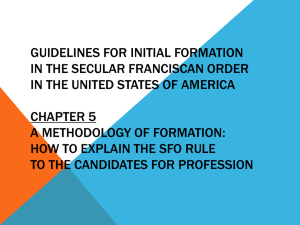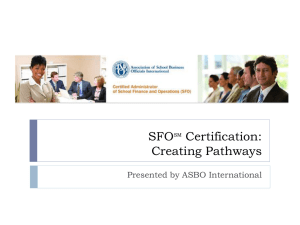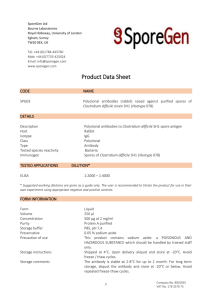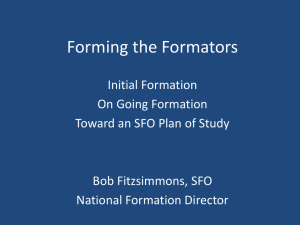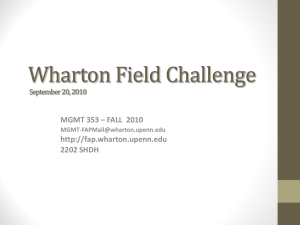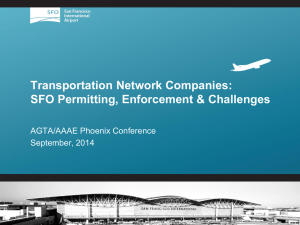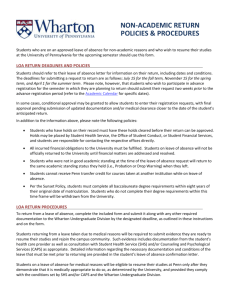Report Highlights for - Wharton Global Family Alliance
advertisement
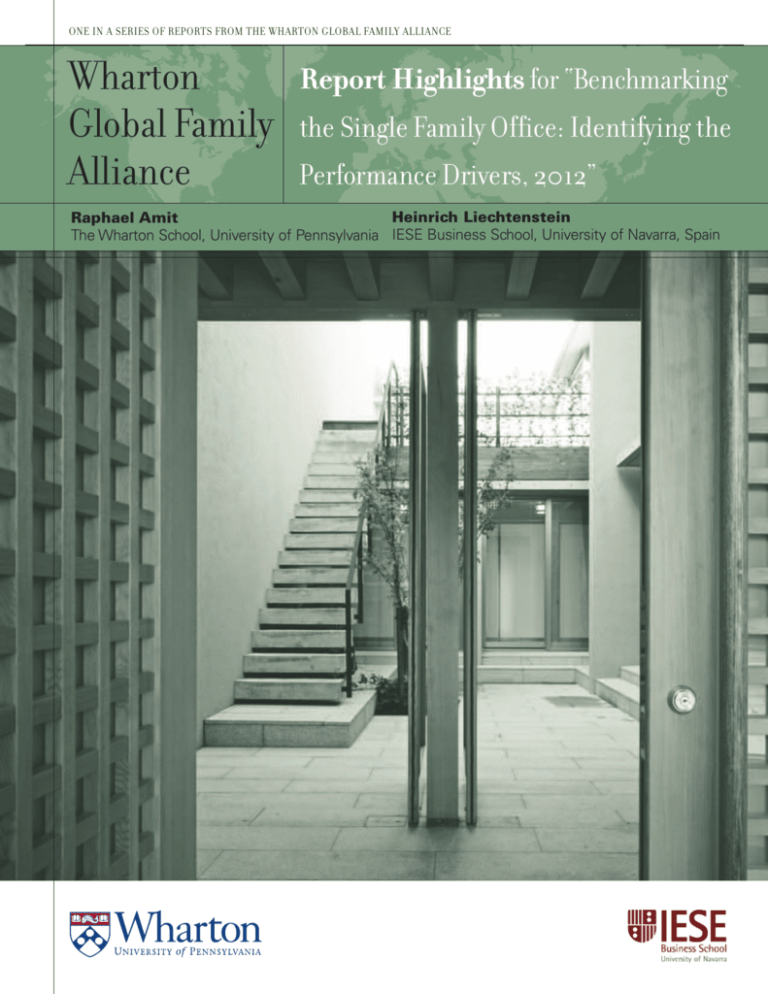
ONE IN A SERIES OF REPORTS FROM THE WHARTON GLOBAL FAMILY ALLIANCE Wharton Global Family Alliance Report Highlights for “Benchmarking the Single Family Office: Identifying the Performance Drivers, 2012” Heinrich Liechtenstein Raphael Amit The Wharton School, University of Pennsylvania IESE Business School, University of Navarra, Spain A Note about this Report Contents Benchmarking the Single Family Office: Identifying the Performance Drivers, 2012 is one in a series of reports from the Wharton Global Family Alliance. The detailed 2012 report regarding the findings of the 2011 survey, conducted in partnership with the Family Business Chair at IESE, is distributed exclusively to family offices that completed the survey. This summary of 2012 Report Highlights is presented to share more widely some of the insights gained on current practices and performance drivers for SFOs around the world. Introduction ________________________________________________________________________ 1 Descriptive Analysis of the SFO Sample________________________________ 3 Performance Drivers of SFOs______________________________________________ 10 Food for Thought________________________________________________________________ 11 “Education as a Unifying Foundation for a Family (Office)”__ 12 Looking Ahead: Future SFO Surveys ___________________________________14 Acknowledgments We thank the team at the Wharton Global Family Alliance, particularly Xu (Henry) Han, Sylvie Beauvais and Greg Pitter for their outstanding support. As well, we are grateful to the team at IESE’s Center for Family-Owned Business and Entrepreneurship (CEFIE), especially to Cristina Marsal. We are indebted to Laird Pendleton, our partner at the CCC Alliance, for his insights and support throughout this project. Introduction This document depicts some of the highlights of the third detailed benchmarking survey undertaken by the Wharton Global Family Alliance in order to develop a better understanding of the performance drivers of Single Family Offices, and to share that emerging knowledge with participating families in a manner that preserves anonymity and confidentiality. A Single Family Office (SFO) is a professional organization, owned and controlled by a single wealthy family. It is dedicated to managing the personal and financial affairs of family members. In addition to managing the personal fortunes of family members, SFOs’ activities often include a range of accounting, legal, educational and personal services which are dedicated and tailored to the exclusive needs of family members. SFOs vary substantially in the scope of activities, in the Assets Under Management (AUM), in the activities that are carried out in house versus those that are outsourced and in other aspects. Given the highly confidential and private nature of SFOs, there has not been a reliable and robust source of information that relates SFO performance to a broad range of SFO practices including governance, documentation, investment management processes, communication, human resources issues, education, succession planning and technology. The Wharton Global Family Alliance (The Wharton GFA) The Wharton GFA (www.wgfa.wharton.upenn.edu), a unit of the Wharton School (www.wharton.upenn.edu), is a unique academic-family business partnership established to enhance the marketplace advantage and the wealth creation contributions of global families that control substantial enterprises and resources. The Wharton GFA focuses its research on key issues affecting global families and their businesses, including Family Business Management and Governance, Wealth Management, and Philanthropy. Thought leadership, knowledge transfer and sharing of ideas and best practices is enabled by combining two highly credible and complementary sources of insight—the practical expertise of successful global families and rigorous scholarly analysis from Wharton faculty. The Wharton GFA’s mission is to create and disseminate groundbreaking knowledge about family-controlled businesses and about the families that are behind these firms, with a high standard of scholarship that has positive real-world impact. The Wharton Global Family Alliance (GFA) partnered with the IESE Business School in the preparation of the 2011 SFO benchmarking survey, and the resulting 2012 report. Our 2011 survey and 2012 report builds upon our studies in 2007 and 2009, responding to the request of families to benchmark the operations of SFOs around the world. By examining at a high level of granularity the governance and management processes of family offices, we wish to illuminate the relationship between the financial performance of SFOs and a broad range of operational aspects, thereby allowing families to learn from each other while maintaining total anonymity and confidentiality. copyright © 2012 by the wharton school and iese school of business introduction 1 The Benchmarking Survey The survey instrument was distributed during the first six months of 2011, in both hard and soft copies, and in four languages: Chinese, English, Italian and Spanish. We received 106 questionnaires from 24 countries around the world. To maintain complete confidentiality, we performed the analyses of the data on a regional basis: the Americas, which includes Canada, Central America, South America and the USA; Europe; and the Rest of the World (RoW), which includes Asia, Australia and the Middle East. The survey includes 10 sections: A. Family background and the SFO B. SFO costs C. SFO financial performance measurements D. SFO governance E. SFO documentation F. SFO processes G. SFO communication H. SFO human resources issues I. SFO education and succession planning J. SFO technology 2 introduction Each section contains a set of detailed questions on issues that are of concern to principals and managers of family offices. In designing the survey, we needed to manage carefully the tradeoff between adding granularity to a section and controlling the overall length of the survey. Descriptive Analysis of the SFO Sample SFO Survey Sample: Families and their Businesses (by Region, Wealth Level and Involvement in Operating Businesses) Figure 1 - Location of SFO Headquarters in 2011 RoW 8.5% Our sample represents SFOs from around the world. Half (50.5%) of the 106 SFOs in our sample locate their headquarters in Europe. Another 41.0% are in the Americas and 8.5% are located in the rest of the world (RoW), as depicted in Figure 1. Figure 2 illustrates the wealth level of the families served by our respondents. More than one-third (37.4%) of respondents have Assets Under Management (AUM) less than $500 million, while 42.4% of the families have AUM in excess of $1 billion. As noted in the sections that follow, the size of AUM is one determinant of how SFOs operate. Figure 3 indicates that more than half (57.5%) of the families in our 2011 sample are involved in operating a family business in addition to the wealth that is managed by their SFO. This represents a 2.5% increase compared to 2009, which suggests an increase in family involvement in operating businesses. Such a trend is also corroborated by the increasing percent of family wealth tied to operating businesses controlled by the family (as illustrated in Figure 4), which shows an increase from 18.3% in 2007 to 34.4% in 2011. Consistent with our past surveys, however, there are strong regional differences. Americas 41.0% Europe 50.5% Figure 2 - Wealth Level of Families in US$ 500m–1b 20.2% >1b 42.4% <500m 37.4% Figure 3 - Family Involvement in Operating Businesses Didn’t Answer 2.8% No 39.7% Yes 57.5% Figure 4 - Percent of Family Wealth Tied to Operating Businesses 0% 5% 2007 copyright © 2012 by the wharton school and iese school of business 10% 2009 15% 20% 25% 30% 35% 2011 descriptive analysis of the sfo sample 3 As indicated in Figure 5, compared with 2009, the level of involvement in operating businesses in 2011 showed a decrease for RoW families, from 88%; an increase for European families, from 58%; and relatively no change for families in the Americas, from 49%. One explanation for the observed decline in the percent of families in RoW (which is primarily Asia) that operate a business is that succession challenges in first-generation Asian families have resulted in the sale of some family businesses. Surprisingly, despite the fact that family offices in Europe are older on average than their counterparts in the Americas, European families are relatively more involved in their businesses. The modest increase in the percent of European families which operate a business can be explained by lack of liquidity in European capital markets and the continuation of financial and economic challenges on the continent, in particular in southern Europe. By contrast, a more liquid capital market in the Americas increases both the temptation and the opportunities for families to sell their business. Figure 6 depicts the number of professionals employed by SFOs serving families with a wealth level less than $1 billion, which we call “millionaires,” and those with a wealth level greater than $1 billion, which we call “billionaires.” As shown in the figure, SFOs serving billionaires expanded on average from 16 professionals in 2009 to 25 professionals in 2011, while SFOs serving millionaires generally reduced their staff between 2009 and 2011. As illustrated by Figure 7, SFOs manage 44.6% of the wealth of billionaires and 65.6% of wealth of millionaires. Moreover, if families are no longer involved in operating businesses, 83.1% of their wealth is under the management of their SFOs. Figure 5 - Family Involvement in Operating Businesses (Regional Breakdown) Yes 2009 2011 No 49% 58% 88% 51% 42% 12% 50% 63.5% 75% 0% 50% 36.5% 25% 100% 20% Americas 60% 80% RoW Figure 6 - Size of SFOs: Number of Professionals Employed (Millionaires and Billionaires) 2007 2009 2011 0 5 10 Millionaires 15 20 Billionaires Figure 7 - Percent of Wealth Managed by SFOs (Wealth and Operating Business Breakdown) Millionaires Billionaires 65.6% 44.6% % of Wealth Managed by SFO Fa Families without Operating Businesses Families with Operating Businesses 36.4% 4 descriptive analysis of the sfo sample 40% Europe 83.1% 25 Scope of the Family Office Figure 8 shows the scope of SFO activities (investment-, family- and administration-related), by region. As the figure indicates, SFOs in the Americas are more versatile, as they perform more family-related and administration-related activities than the SFOs in Europe and RoW while putting equal emphasis on investment-related activities. In other words, in addition to their investment activities, SFOs in the Americas are engaged in more “soft” responsibilities than their counterparts in Europe and RoW. Figure 8 - Median Number of SFO Activities (Regional Breakdown) Investment Family Administration copyright © 2012 by the wharton school and iese school of business 0 1 2 Americas 3 Europe 4 5 6 7 RoW descriptive analysis of the sfo sample 5 8 We find significant differences between SFOs serving families with operating businesses and those without operating businesses. As illustrated by Figure 9 (see page 7), SFOs of families with operating businesses put more emphasis on familyrelated activities (e.g., education of family members, estate planning) and administration-related activities (trust accounting). This seems to suggest that the asset management of such families is more complicated and intertwined with a variety of family issues (e.g., succession or family control) which are in need of more professional hands. One noteworthy change in how SFOs rate their activities is the emergence of risk management as a highly rated SFO activity after the financial crisis. Figure 10 compares the five highest-rated SFO activities in 2007, 2009 and 2011. As we can see, risk management first appears among the top five most important activities in 2011, which might be a reflection of the lessons learned from the financial crisis. Figure 10 - Top Five SFO Activities (2007, 2009, 2011) Activities 2007 Rating Activities 2009 Rating 3.4 Asset allocation 3.3 Manager selection & monitoring 3.3 Investing 3.3 Information aggregating & client reporting 3.1 Manager selection & monitoring 3.1 Estate planning 2.8 Investment performance measurement 2.9 Legal services 2.6 Estate planning 2.8 Asset allocation Most valued=4, least valued=0 6 descriptive analysis of the sfo sample Activities 2011 Rating Asset allocation 3.3 Investing 3.2 Manager selection & monitoring 3.1 Risk management 2.9 Estate planning 2.8 Figure 9 - Rating of SFO Activities (Mean and Operating Business Breakdown)* Investment-related Activities Asset allocation Manager selection & monitoring Investing Investment performance measurement Risk management 0.0 0.5 1.0 1.5 2.0 2.5 3.0 3.5 4.0 1.0 1.5 2.0 2.5 3.0 3.5 4.0 1.5 2.0 2.5 3.0 3.5 4.0 Family-related Activities Education of family members Philanthropy Insurance Concierge services & security Estate planning 0.0 0.5 Administration-related Activities Banking Financial administration Information aggregating & client reporting Legal services Technology solutions & support Trust accounting Pooled or partnership accounting 0.0 0.5 1.0 *Ranking of the activities is based on overall rating. Most valued=4, least valued=0 Mean Families with Operating Businesses copyright © 2012 by the wharton school and iese school of business Families without Operating Businesses descriptive analysis of the sfo sample 7 Figure 11 compares the expense distributions of SFOs in the Americas and in Europe.1 As the table indicates, SFOs in Europe spend a larger proportion of money on investment-related activities than SFOs in the Americas. Within the investment expenses category, SFOs in the Americas commit a larger part of their expenses to third-party vendors than SFOs in Europe. by technology providers. Adaptability to the SFO’s specific context is the most valued feature for both ASP custody platforms and ASP consolidation/aggregation platforms, followed closely by ease of use and accessibility, while price is the least important criteria for selecting platforms. 1 The custody platform and the consolidation/aggregation platform are key technologies used for the operation of SFOs. Figure 12 illustrates how SFOs evaluate the platforms offered A note about our regional analysis: Our goal is to present the most comprehensive but confidential picture possible of SFOs around the world. Wherever possible, we include all three regions. However, in order to preserve the anonymity of our SFO respondents, several regional breakdown charts in the report focus on Europe and the Americas. Figure 11 - SFO Expense Distribution (Regional Breakdown) SFO Expense Distribution Investment expenses Noninvestment expenses Americas Europe In-House 20.8% 49.3% Outsourced 45.1% 22.2% Sub-Total 65.9% 71.6% In-House 19.3% 16.9% Outsourced 14.8% 11.6% Sub-Total 34.1% 28.4% Figure 12 - SFO Technology: Criteria for Selecting the Technology Platform Ease of use and accessibility Adaptability to my context Price Complete confidentiality 0.0 0.5 1.0 Most valued=5, least valued=1 ASP Custody platform ASP Consolidation/aggregation platform 8 descriptive analysis of the sfo sample 1.5 2.0 2.5 3.0 3.5 Custodians and Investment Managers Custodians are the organizations that hold assets for wealthy families. In Figure 13, we compare the number of custodians used by SFOs in 2009 and 2011. We find increasing divergence among SFOs with respect to their attitude towards custodians. SFOs using only one custodian increased from 23.5% in 2009 to 28.7% in 2011; however, SFOs using more than 5 custodians increased from 7.6% to 17.0% at the same time. As a result, fewer SFOs are “stuck in the middle,” which suggests a sharper positioning or differentiation in terms of SFOs’ investment strategy. Figure 14 depicts the number of external investment managers used by the SFOs. We find that in 2011, SFOs in general used more external investment managers than before, as evidenced by the increasing percent of SFOs hiring more than 10 external investment managers (from 45.6% in 2009 to 59.3% in 2011). This further demonstrates the desire of SFOs to reduce their exposure to any particular asset manager, by spreading their assets among more managers. Figure 13 - Number of Custodians (2009 vs. 2011) 1 2 3 4 5 More than 5 0% 5% 10% 15% 20% 25% 30% 2011 2009 Figure 14 - Number of External Investment Managers (2009 vs. 2011) <5 5-10 11-20 21-30 31-40 > 40 0% 5% 2009 copyright © 2012 by the wharton school and iese school of business 10% 15% 20% 25% 30% 35% 40% 2011 descriptive analysis of the sfo sample 9 Performance Drivers of SFOs One of the major objectives of our 2011 benchmarking survey is to determine which SFO policies and practices appear to have the greatest impact on performance. By comparing the results from our 2011 survey with our 2009 survey, we also seek to reveal how these performance drivers change over time. In 2009, we identified four broad categories in which highperforming SFOs exhibited significant differences compared to low-performing SFOs. We called these drivers: “In-house advantage,” “Quality pays off,” “Family involvement enhances performance” and “Entrepreneurial mindset makes a difference.” In our 2011 survey, three of these categories continue to stand out as important performance drivers (the use of in-house vs. outsourced services, attention to quality and entrepreneurial mindset). The level of family involvement in high-performing SFOs appears to have declined, although it remains higher than in low-performing SFOs. A new category that bears emphasis this year is scale and focus. Specifically, to investigate if there is any relationship between the performance of the SFO and the wealth level of the family it serves, we examine the percentage of highperforming SFOs in each wealth category (millionaires and billionaires). We find that SFOs serving billionaires have outperformed those serving millionaires consistently over the years. In other words, SFOs’ performance appears to be linked with the scale of their deployable capital. 10 performance drivers of sfos We also examine the relationship between the performance of the SFO and the wealth distribution of the family. In particular, we focus on the percent of family wealth tied to operating businesses controlled by the family and the percent of family wealth which is not tied to the operating businesses and which is managed by the SFO. Interestingly, we find a negative association for the former and a positive association for the latter. Among high-performing SFOs there is less family wealth tied to the family’s operating businesses (23%). However, a greater percentage of the family wealth managed by the SFO is not tied to the family’s operating businesses (68%) relative to low performers. For low-performing SFOs, the distribution of family wealth managed by the SFO was more evenly divided between business and non-business (approximately 45% each). This seems to suggest the importance of focus for SFO performance, as well as the distinct roles of SFOs for families at different stages. For instance, when a large percent of family wealth is still tied to family businesses (which is more likely to happen in the first or second generation), the role of the SFO is more like a holding company whose responsibility is not only to maximize investment return, but also to finance and sustain legacy and new family businesses. However, when a large percent of family wealth is not tied to family business and is managed by SFOs (which is more likely to happen in later generations that have achieved liquidity from family businesses), the SFO acts more like a professional investment institution, for which maximizing investment performance is a primary goal. Food for Thought In order to put the main findings of the 2012 report in perspective, it is worth repeating some of the findings from our 2009 report: • In-house vs. outsourcing: The more an SFO conducts its activities in-house and the more family members were involved, the better the performance. • Quality: The quality of investment management processes and governance practices in the family office enhances financial performance. • Strategic approach to investment management: Strategic approaches to decision making in SFOs allow SFO principals to develop core competencies which in the long run will lead to stronger sustainable performance. (This had proven especially valuable during the global economic crisis, when SFOs with a disciplined strategic approach were better able to resist the temptation to follow advice that flowed from mathematical and statistical models.) • • The frequency with which SFOs inform families about investments and general activities has increased overall, and high performers continue to present a higher level of detail than low performers. • Education programs for next-generation family members are one area where there has been a shift from in-house seminars to outside educational institutions and vendors, as well as an increased focus on internships in family businesses. In addition, these opportunities are now being offered to younger members of the family, especially those who are 16-20 years of age. Major findings and observations of the 2012 report include the following: • Families are substantially enhancing their risk management capabilities, as they internalize the lessons from the 2008 crisis. SFOs are putting more emphasis on managing the risk of their investments, which is evidenced by more diversified investment portfolios, higher value placed on risk management as an SFO activity and increased use of a wider range of risk measures, including less traditional measures, especially among higher wealth, billionaire SFOs. • Families are deeply concerned about potential vendor conflicts of interest. This has led to the internalization of activities that were in the past outsourced. SFOs commit more resources to investment-related activities and more frequently conduct these activities in-house. SFOs have also enhanced the process of manager selection and monitoring. High-performing SFOs continue to expand their capability to handle key activities in-house, most notably in investment-related activities, but also in family- and administration-related activities. • An entrepreneurial mindset, as evidenced by SFO incentive schemes, asset allocation and optimism about future performance, correlates with higher annual net returns. In terms of expense-adjusted quality, high-performing SFOs again far surpass low-performing SFOs across six key pillars of quality: governance, documentation, investment management processes, communication, human resources issues and education and succession planning. Finally, we observe once again that the professionalization of operations and proper governance and performance are positively correlated. The main message here is that attempts to cut corners and save on expenses adversely affect performance. Governance, communication, education: The quality index shows that the more you invest in a governance structure for your SFO, the more you communicate and interact with the family members and the more you invest in the education of the next generation, the better the performance will be. Our 2012 report reconfirms these findings, and in several cases shows that steps have been taken in the direction suggested by the 2009 report: • • copyright © 2012 by the wharton school and iese school of business food for thought 11 Education as a Unifying Foundation for a Family (Office) The Challenge: How to unify an increasingly The Solution international family? The Family Office was asked to implement the following plan: Children of modern families may have far less in common than in preceding generations. It is quite possible for many families once defined by national businesses and a single national culture now to be far more diverse—and hence have far less in common. The different branches of a family may now be brought up in different countries with different languages, different cultures and religions, and with attitudes and relationships so different that they may struggle to find enough common ground to perceive themselves as belonging to one family with a common value system. There is no doubt that this phenomenon is going to increase due to globalization and even further fragmentation, trends which pose great challenges to families who want to share business leadership, manage family assets in a common pool, and stay united and harmonious based on a common family value system. The Family and Family Office This old French industrial family has stayed together across generations. All family members older than age 40 were educated in the traditional elite French schooling system and lived their childhoods in France. Now, however, with a substantial portion of the 82 family members living outside of France (in the US, Sweden, Australia, Turkey, South Africa and Indonesia) or being married to non-French (and often non-French speaking) spouses, there is the challenge of finding common ground for the future no longer provided by having a common language and a common national family culture. Many of the children of these international couples speak French badly (if at all), know little about France, and have had a very different cultural experience and understanding from prior generations. In their last family gathering (which was paid for by the Family Office and was quite a logistical exercise) the family discussed how to overcome the danger of a disintegrating family due to such a dispersed set of family members and diluted sense of family history, values and culture. 12 education as a unifying foundation 1. The frequency of family meetings was increased from one every 5 years to one every year. Instead of being basically a wining and dining event, the meeting became a mixture of socializing and integrating games, discussion rounds on relevant family, family business and family investment topics, and the telling of family stories. It was set up in a way that in the two-and-ahalf days allocated to the event nearly everyone in attendance had to communicate with everyone else at least once. Furthermore, there were six weeks of common activities organized in a vast summer house, where all family members could take a week of vacation with their families, sharing with other family members a bonding week of holiday and mutual activity. 2. One family member was asked to transform the existing family academy for the employees of the different family businesses into a platform also relevant for the exploring and solving of family issues. As an example, next-generation seminars on soft issues for family members and members of like-minded families were organized. 3. Special educational programs on issues of interest to family members were also organized. One was for all married family members with children on what a good education means; another was prepared on the special responsibilities of businesses, for wealth and society. 4. The Family Office became expert in schooling and universities across the world and opened dialogue with the family which had truly begun to think deeply and strategically about effective education. Not all courses and opportunities were traditional family affairs: courses were developed on how to learn the Chinese language in the most effective way, how to enter elite army forces, how to develop the right knowledge to support an extensive art collection, and other topics aimed at directly enriching the family experience—and indirectly strengthening the family’s foundations and common platform of history, aspiration and values. 5. One of the greatest challenges was, and still is, to guarantee that all family members learn French, regardless if born into a family whose primary mode of communication was in a local language. Even the families that sent their children to the local French school or had a French-speaking nanny were often not really successful in having French as an equal alternative to the local language or to the international common platform for business, technology and social networking provided by English. To facilitate the tradition of visiting as many other family members as possible each year, and to have an ongoing communication in French, an intranet for the family was established with support across all branches for high-quality French tuition and learning support. What Does This Case Prove to Us? 1. The impact of globalization extends not only to businesses, but to families. Once a family gets to a certain size and state of geographic distribution, it is necessary to develop a conscious program that ensures that the different family members spend enough time together to assure unity and a common culture. This may in many cases involve language development as well, to preserve family-wide communication in the native language of the founding family. 2. If unity and a common culture are considered of sufficient value, then it may be necessary for the family and Family Office to invest a substantial amount of time, thought, effort and money to achieving these goals. 6. Finally, in order to preserve the common history, the most emblematic stories of family history mentioning its most important members were drafted and promulgated in book form to pass on values, history and identity to all members of the next, and succeeding, generations. copyright © 2012 by the wharton school and iese school of business education as a unifying foundation 13 Looking Ahead: Future SFO Surveys Benchmarking the Single Family Office: Identifying the Performance Drivers, 2012 is one in a series of reports from the Wharton Global Family Alliance. The detailed 2012 report based on the 2011 survey findings is distributed exclusively to family offices that completed the survey. Wharton GFA is committed to continuing its study of family offices with the goal of contributing to the ability of family offices to preserve and enhance all forms of family wealth. Our plan is to conduct a comprehensive survey every other 14 looking ahead year and to address at a higher frequency specialized topics of interest to family offices, such as family office governance and compensation for professionals. For information on this and other reports—or should you be interested in participating with us in future surveys—please email wgfa@wharton.upenn.edu. Wharton Global Family Alliance Prof. Raphael Amit amit@wharton.upenn.edu The Wharton School University of Pennsylvania Vance Hall, 4th Floor 3733 Spruce Street Philadelphia, PA 19104-6374 +1 215.898.4470 phone +1 215.898.1905 fax wgfa@wharton.upenn.edu IESE Business School Prof. Heinrich Liechtenstein hl@iese.edu IESE Business School Avenida Pearson 21 08034 Barcelona / Spain +34 2534200 phone +34 2534343 fax
